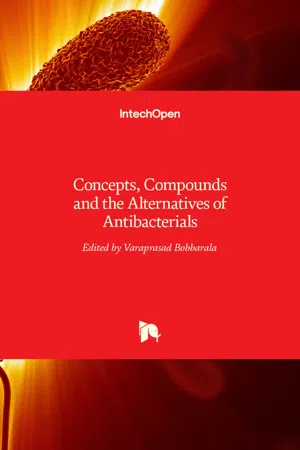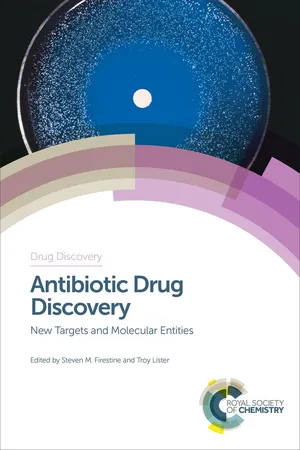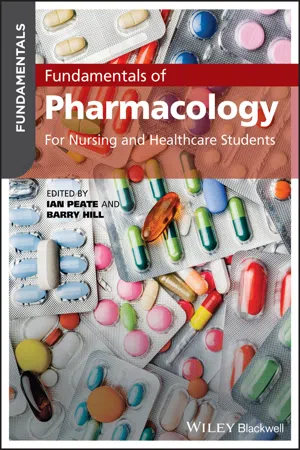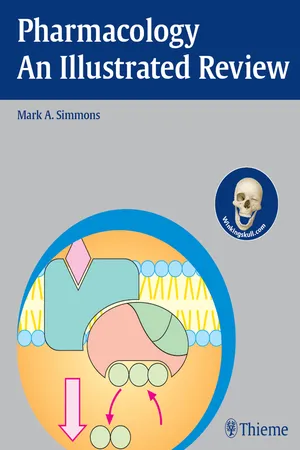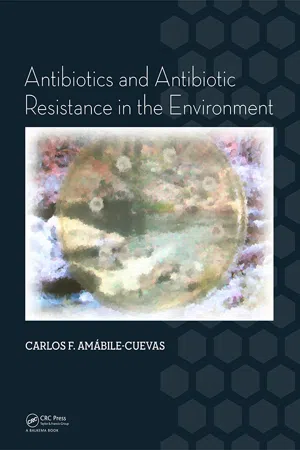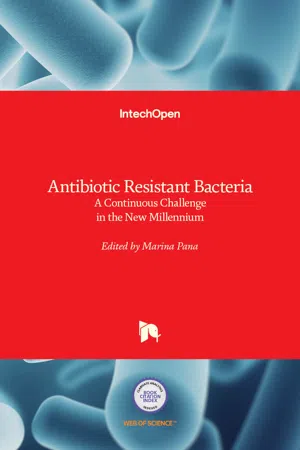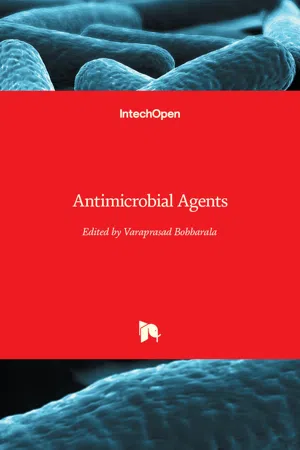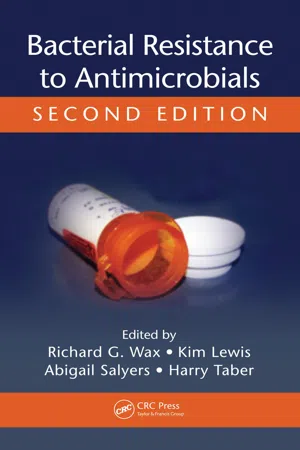Biological Sciences
Broad Spectrum Antibiotic
A broad-spectrum antibiotic is a type of medication that is effective against a wide range of bacteria, including both Gram-positive and Gram-negative bacteria. These antibiotics are often used when the specific bacteria causing an infection are unknown, or when multiple types of bacteria are suspected. While broad-spectrum antibiotics can be effective in treating a variety of infections, they may also lead to antibiotic resistance and disruption of the body's natural microbiota.
Written by Perlego with AI-assistance
Related key terms
1 of 5
8 Key excerpts on "Broad Spectrum Antibiotic"
- Varaprasad Bobbarala(Author)
- 2015(Publication Date)
- IntechOpen(Publisher)
◦ the broad-spectrum drug affects a wide range of disease-causing bacteria, including both Gram-positive and Gram-negative bacteria ◦ the narrow-spectrum antibacterial drug, which acts against specific families of bacteria. For example, ampicillin is a widely used broad-spectrum antibiotic. For a better understanding of the different types of antimicrobial drugs, Figure 2 displays the main classes of these substances and their applications. Figure 2. Classification of antimicrobial drugs and their applications Antibiotics act by inhibiting the basic life-sustaining processes in the microorganism. In order to minimize toxicity, the targets of antibiotics must be selective. However, all antibiotics are toxic to some degree. Selective toxicity should be focused on harming the bacteria, not the host. Selection of the appropriate antibiotic depends on the following parameters: • Knowledge of organism’s natural resistance • Pharmacological properties of the antibiotic toxicity, binding, distribution, absorption achievable levels in blood, urine • Previous experience with same species • Nature of patients underlying pathology • Patient’s immune status Concepts, Compounds and the Alternatives of Antibacterials 6 Evaluation of susceptibility focuses mainly on the interaction of antimicrobial agents, the organisms, and their resistance mechanisms. The resistance to antimicrobial drugs is based on several mechanisms, including the following: • Microbes may generate drug-metabolizing enzymes (such as penicillinase) • Microbes may cease active uptake of certain drugs • Microbial drug receptors may suffer change resulting in reduced antibiotic binding and action • Microbes may produce compounds that antagonize drug actions Susceptibility tests are essentially artificial measurements that include in vitro response, approximate range of effective inhibitory action and reflect possible error equivalent to one tube dilution.- eBook - ePub
Antibiotic Drug Discovery
New Targets and Molecular Entities
- Steven M Firestine, Troy Lister(Authors)
- 2017(Publication Date)
- Royal Society of Chemistry(Publisher)
The extent of coverage across the collection of known pathogenic species has provided a basis for a rough classification as either broad or narrow spectrum. While this classification arose from a relative comparison between generations of agents within an antibacterial class, this distinction faded over time with the continued discovery of new classes and subsequent generations of compounds that varied in potency across the range of pathogenic bacterial organisms. Like the adage, “How long is a piece of string?”, the debate of narrow versus broad spectrum is highly contextual and dependent on the clinical indication and the underlying microbiological standard of care. For example, cephalosporins are typically considered broad-spectrum agents, particularly when compared to the comparatively narrower spectrum of the natural penicillins. However, cephalosporins can also be considered narrow-spectrum agents relative to subsequent generations of β-lactam antibiotics when activity against intracellular pathogens, anaerobes and non-fermenting organisms is considered. 6 For these reasons, the classification on antibacterial spectrum remains controversial and some have called for redefining these classifications based on other key factors, such as clinical indication and drug distribution to targeted organs, or even on the limitations in spectrum coverage, either through inherent or acquired resistance mechanisms. 7 Despite this debate, it is clear that, from a clinical infectious diseases perspective, broader spectrum coverage facilitates an empirical approach to antimicrobial therapy. This is particularly evident for serious infections, where clinical outcomes are directly linked to the elapsed time between case presentation and appropriate antibiotic intervention - eBook - PDF
Fundamentals of Pharmacology
For Nursing and Healthcare Students
- Ian Peate, Barry Hill, Ian Peate, Barry Hill(Authors)
- 2021(Publication Date)
- Wiley-Blackwell(Publisher)
The next part, sensitivity testing, is to determine the appropriate therapy. There are two main categories of antibiotics, based on the spectrum of their activity: broad spectrum and narrow spectrum. Table 9.2 below details the main differences with examples. Another key factor that must be given much consideration, is the patient. The clinician must take note of the patient’s allergy history, liver (hepatic) and kidney (renal) function, sus-ceptibility to disease, route tolerance (for example, ability to swallow), severity of illness, race and ethnicity (influence on pharmacokinetics due to differing genetics [Zurlinden and Reisfeld, 2017]), age, concomitant medication intake and pregnancy status, if breast-feeding, or taking oral contraceptives (Joint Formulary Committee, 2020a). POST (2017) states that inappropriate prescribing of antibiotics increases antimicrobial resistance (AMR). Antimicrobial resistance The World Health Organisation (2018a) defines AMR as ‘the ability of microorganisms (like bac-teria, viruses and some parasites) to stop an antimicrobial (such as antibiotics, antivirals and antimalarials) from working against it. As a result, standard treatments become ineffective, infections persist and may spread to others’. Globally, the focus toward AMR, considered a public health priority, is gathering pace as there is a concentrated effort to decrease antibiotic usage due to increasing resistance making infections harder to treat and the added cost to individuals (increased mortality) and health-care providers (longer stays and higher costs) (Burchum and Rosenthal, 2019). Table 9.2 Broad- and narrow-spectrum antibiotics with examples. Broad-spectrum antibiotics Narrow-spectrum antibiotics Effective against a wide variety of microorganisms. Kill variety of organisms. Useful if the cause of infection is unknown. For example, erythromycin, ciprofloxacin and doxycycline. Effective against only specific microorganisms. Causative organisms are known. - eBook - PDF
- Mark A. Simmons(Author)
- 2011(Publication Date)
- Thieme(Publisher)
Fig. 28.1 ▶ Bacteriostatic versus bactericidal antibacterial agents. Bacteria are able to multiply in vitro in a growth medium if conditions are favorable. If the growth medium contains an antibiotic, the bacteria may be killed (bactericidal effect), or the bacteria may survive but are unable to multiple (bacteriostatic effect). 1 day Antibiotic Bacteriostatic Bactericidal Antimicrobial Drugs 282 — Bacteriostatic agents primarily inhibit bacterial growth. Killing of the organism is then de -pendent upon host defense mechanisms. The disadvantage of these agents is that in the set-ting of inadequate host defense mechanisms, any partially inhibited organisms may survive, replicate, and produce recurrent disease when the antibiotic is discontinued. — Bactericidal agents are capable of killing the bacteria and are preferable if the patient has neutropenia or immunosuppression. Spectra of Antimicrobial Agents Antimicrobial agents are further classified into spectra depending on the range of microorgan-isms on which they act: — Narrow-spectrum agents are effective against a limited range of microorganisms. — Extended-spectrum agents are principally effective against gram-positive bacteria, but they are also effective against a significant range of gram-negative bacteria. — Broad-spectrum agents are effective against a wide range of microorganisms. The use of broad-spectrum antibiotics should be limited, as they predispose patients to superinfection (the appearance of a new infection during treatment) by disrupting the body’s natural bacterial flora. 28.2 Selection of Antimicrobial Agents The selection of antimicrobial agents involves the consideration of many factors relating to the microorganisms involved, patient (host) factors, and pharmacology of the agents themselves. Microorganism Factors Species of Microorganism Successful treatment of an infection requires knowledge of the pathogen(s) involved. - Carlos F. Amabile-Cuevas(Author)
- 2015(Publication Date)
- CRC Press(Publisher)
This definition would therefore include all drugs, of natural or synthetic origin, used against bacte-ria; and would exclude compounds used against viruses, fungi, protozoans or other microorganisms, as well as non-selective biocides, such as disinfectants and antiseptics. 1.1.1 Origin and mechanism of action of main antibiotic classes Although it is not within the purview of this book to enlist and review the origin and mechanism of action of each class of antibiotics, having an overview included could be helpful for the reader not well versed into this mainly pharmacological area. It may be important to point out that a sort of unifying mechanism of action of bactericidal antibiotics, through a common pathway of generating reactive oxygen species, recently proposed (Kohanski et al., 2007), was first shown to be inconsistent with physiological evidence (Mahoney and Silhavy, 2013), and then most likely to be based on a labo-ratory artifact (Renggli et al., 2013). It is also important to emphasize that these are the mechanisms of bacteriostatic or bactericidal effects of high, clinically-attainable concentrations of antibiotics; as will be discussed below, this could very well be a human-made situation, with natural antibiotics actually exerting other physiological roles at much lower concentrations. The following paragraphs enlist some relevant information about each antibiotic class, with those that include mostly natural prod-ucts first. For additional information on the chemistry, pharmacology and clinical uses of each drug, two comprehensive texts can be useful: Bryskier A. (ed.) Antimicrobial agents, antibacterials and antifungals ; ASM Press, Washington DC, 2005; and Grayson M.L. et al. (eds.) Kucers’ The use of antibiotics , 6th ed; Hodder Arnold, London, 2010.- eBook - PDF
Antibiotic Resistant Bacteria
A Continuous Challenge in the New Millennium
- Marina Pana(Author)
- 2012(Publication Date)
- IntechOpen(Publisher)
Part 1 Assessment of Antibiotic Resistance in Clinical Relevant Bacteria 1 Antibiotic Resistance: An Emerging Global Headache Maimoona Ahmed King Abdul Aziz University Hospital, Jeddah, Saudi Arabia 1. Introduction The discovery of antibiotics was one of the greatest achievements of the twentieth century. The subsequent introduction of sulphonamides, penicillin and streptomycin, broad spectrum bacteriostatic antibiotics, bactericidal antibiotics, synthetic chemicals and highly specific narrow spectrum antibiotics to clinical medicine transformed the treatment of bacterial diseases (Baldry, 1976). However, due to the excessive and inappropriate use of antibiotics there has been a gradual emergence of populations of antibiotic –resistant bacteria, which pose a global public health problem (Komolafe, 2003). According to the WHO, a resistant microbe is one which is not killed by an antimicrobial agent after a standard course of treatment (WHO, 1998). Antibiotic resistance is acquired by a natural selection process. Antibiotic use to combat infection, forces bacteria to either adapt or die irrespective of the dosage or time span. The surviving bacteria carry the drug resistance gene, which can then be transferred either within the species/genus or to other unrelated species (Wise, 1998). Clinical resistance is a complex phenomenon and its manifestation is dependent on the type of bacterium, the site of infection, distribution of antibiotic in the body, concentration of the antibiotic at the site of infection and the immune status of the patient (Hawkey, 1998). Antibiotic resistance is a global problem. While several pathogenic bacteria are resistant to first line Broad Spectrum Antibiotics, new resistant strains have resulted from the introduction of new drugs (Kunin, 1993, Sack et al , 1997, Rahal et al, 1997, Hoge, 1998). - eBook - PDF
- Varaprasad Bobbarala(Author)
- 2012(Publication Date)
- IntechOpen(Publisher)
Meanwhile, the development and spread of bacterial resistance was steadily incising into our antibacterial arsenal (Fig. 1). Future Antibiotic Agents: Turning to Nature for Inspiration 27 Fig. 1. Timeline for the introduction of major, broad-spectrum antibiotic classes for systemic application in the clinic, and documented occurrence of bacterial resistance (adapted from (Brötz-Oesterhelt & Sass, 2010)). The asterisk denotes two new antibiotic classes with single representatives (i.e., lipopeptide daptomycin, and pleuromutulin retapamulin), both of which are intended for topical application. However, analogues for systemic application (oral or i.v. ) are being developed (also see section 3.1.4). ESBL – extended spectrum β -lactamase, VISA – vancomycin intermediately resistant Staphylococcus aureus , VRE – vancomycin-resistant Enterococcus , VRSA – vancomycin highly resistant S. aureus . 2.2 The disappointing investment in combinatorial chemistry and high-throughput screening in antibiotic discovery Rediscovery of known antibiotics from screening microbial extracts and the development of highly effective synthetic (fluoro)quinolones caused a shift in antimicrobial drug R&D strategy in the industry. The search for antibiotics occurring in the environment was mostly abandoned (although semisynthetic modification of natural scaffolds resulted in numerous improved antibiotics (Fischbach & Walsh, 2009)) and the screening efforts were once again invested in synthetic compounds. Since the early 1990’s combinatorial chemistry was employed to produce large libraries of compounds that demanded high-throughput assaying for activity. The advent of genomics and bioinformatics raised the hopes for identification of entirely new antibacterial targets by mining bacterial genomes. - eBook - PDF
- Richard G. Wax, Kim Lewis, Abigail A. Salyers, Harry Taber, Richard G. Wax, Kim Lewis, Abigail A. Salyers, Harry Taber(Authors)
- 2007(Publication Date)
- CRC Press(Publisher)
However, if the goal is to identify a broad-spectrum inhibitor (even one limited to the Gram-positive bacteria as an example) the number of potential targets drops precipitously. It is the view here that, for the near future, narrowly targeted, pathogen-specific drugs will find little clinical utility and even smaller markets (but are likely to be quite expensive, if not pro-hibitively so). This, however, is the subject for discussion elsewhere (although it clearly affects how many view antibacterial drug discovery, that is, taking a patho-gen-specific route). So why hasn’t target-based screening led to a plethora of novel antibacterial agents? The fact is that progress is being made and novel, target-based agents are moving, albeit slowly, into clinical development. But, unlike other fields of therapeu-tic endeavor (e.g., Alzheimer’s disease), there are already scores of safe and effective antibacterial agents that set the bar quite high for new drugs. Also given the decades of empiric screening for antibacterial activity, the law of diminishing returns dic-tates that it will require increasing resources to find the next novel class of antibiotics and that, indeed, has been the experience. NOVEL APPROACHES FOR THE 21ST CENTURY T ARGETING R ESISTANCE Probably the most successful (commercially and probably clinically) class of anti-bacterial agents has been a β -lactam antibiotic coupled with an inhibitor of β -lactamases. It is, therefore, not just theoretically possible to target a resistance mechanism and develop a clinical and commercially viable combination therapy, it has been an extremely successful approach. Perhaps the most common resistance determinants are efflux pumps [12]. While these pumps are much more diverse in genetics and structure than the β -lactamases, they do share a fair amount of structural similarity.
Index pages curate the most relevant extracts from our library of academic textbooks. They’ve been created using an in-house natural language model (NLM), each adding context and meaning to key research topics.
